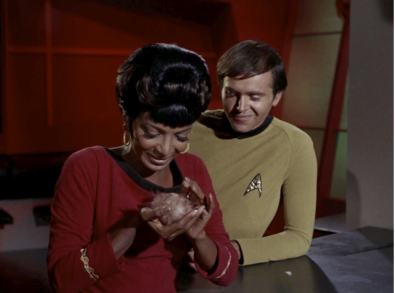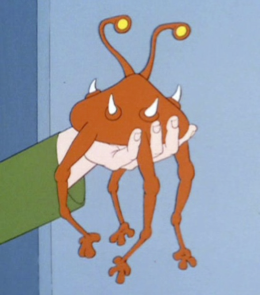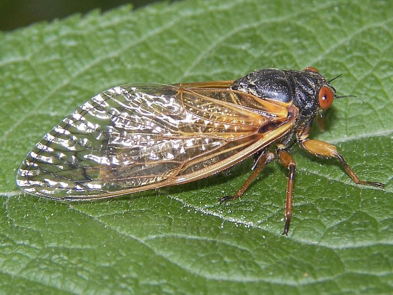This is the second in a series of posts about the maths of Star Trek. Part I covered the probability of survival while wearing a red shirt.
The Mathematics of Alien Biology
In ‘The Trouble with Tribbles’ the Enterprise are assigned to space station K-7 to guard a shipment of grain. Meanwhile, Kirk has to deal with the officious bureaucrat Baris, a rowdy crew of Klingons, and an infestation of tribbles.
Tribbles are cute little hairballs that make soothing chirping noises as you pet them. Unfortunately, they are also born pregnant, so their population grows very, very quickly, making them a pest which soon completely overruns the Enterprise and space station.
In fact, the population of tribbles is said to grow geometrically. Sulu gives a very eloquent description of geometric growth while describing Gary Mitchell’s growing god-like powers in the pilot episode ‘Where No Man Has Gone Before’;
SULU: If you want the mathematics of this, Mitchell’s ability is increasing geometrically. That is, like having a penny, doubling it every day. In a month, you’ll be a millionaire.
I really like this explanation. Geometric growth means each step is multiplied by a common factor. Doubling a penny 30 times would give $1 × 2^{30} = 1,073,741,824$ pennies – or about 10 million dollars.
In ‘The Trouble with Tribbles’ Spock makes a similar calculation to estimate the population of tribbles:
SPOCK: They seem to be gorged.
BARIS: Gorged? On my grain? Kirk, I am going to hold you responsible. There must be thousands of them.
KIRK: Hundreds of thousands.
SPOCK: One million seven hundred seventy one thousand five hundred sixty one. That’s assuming one tribble, multiplying with an average litter of ten, producing a new generation every twelve hours over a period of three days.
KIRK: That’s assuming they got here three days ago.
SPOCK: And allowing for the amount of grain consumed and the volume of the storage compartment.
Classic Spock, but was this number just made up – or had the writer of the episode, David Gerrold, actually done the maths? Let’s find out:
According to Spock, each generation is ten times larger than the previous generation. This means that if we start with a population of $P$ tribbles, the next generation will be $10P$ tribbles, making $11P$ tribbles altogether. So we see that the population increases by a factor of 11 every 12 hours. If we start with 1 tribble, then after three days the population will have multiplied by 11 six times, making $1 \times 11^6 = 1{,}771{,}561$ tribbles – just as Spock claimed!
I question the wisdom of giving the answer to seven significant figures, considering how much estimation is needed. But let’s not quibble about tribbles. The important thing is – the maths was right! I was so surprised I nearly fell off my captain’s log.
The tribble home world must be pretty inhospitable, or have some fearsome predators, to give rise to a species that grows so rapidly. (We even meet a genetically engineered predator in Star Trek: The Animated Series called the glommer, but I digress).
Population growth is one of the areas studied in mathematical biology, a subject that can be used to explain some of the other biological quirks we encounter in Star Trek.
In one of the most celebrated episodes, ‘Amok Time’, we learn more about the character of Spock, his Vulcan heritage and his alien biology. The crew are concerned when Spock appears to acting out of character, he is acting emotionally and irrationally. The reason turns out to be biological, Spock must return to the planet Vulcan and choose a mate:
SPOCK: How do Vulcans choose their mates? Haven’t you wondered?
KIRK: I guess the rest of us assume that it’s done quite logically.
SPOCK: No. No. It is not. We shield it with ritual and customs shrouded in antiquity. You humans have no conception. It strips our minds from us. It brings a madness which rips away our veneer of civilisation. It is the pon farr. The time of mating. There are precedents in nature, Captain. The giant eelbirds of Regulus Five, once each eleven years they must return to the caverns where they hatched. On your Earth, the salmon. They must return to that one stream where they were born, to spawn or die in trying.
KIRK: But you’re not a fish, Mister Spock. You’re…
SPOCK: No. Nor am I a man. I’m a Vulcan. I’d hoped I would be spared this, but the ancient drives are too strong. Eventually, they catch up with us, and we are driven by forces we cannot control to return home and take a wife. Or die.
Although not mentioned explicitly in the episode itself, it is later established that Spock must return to Vulcan every 7 years. And we do indeed find this type of behaviour in nature. Famously, in the insect world the cicada of North America have long life-cycles, where they live underground, but then emerge every 13 or 17 years to mate. They make so much noise in the process of attracting a mate that the local community are forced to move out until it’s over.
However, it isn’t just a coincidence that the life cycles are both prime numbers. Evolutionary biologist Stephen Jay Gould suggested that this mechanism evolved in order to keep the cicadas out of step with the life cycles of local predators. For example, if the cicada had a life-cycle of 18 years, and a predator in the area had a life-cycle of 6 years, then these cycles would coincide every 18 years – that’s every generation of cicada and every third generation of predator. But if the cicada have a life-cycle of 17 years, then the two will coincide only every 102 years – that’s 17 generations of predators, and so the predators never develop a taste for the cicada.
Maybe evolutionary mechanisms existed on Vulcan to cause the people to behave in a similar way to the cicada – after all, 7 is a prime number too.
One of the most memorable images in the original Star Trek occurred in their otherwise troublesome third season. In ‘Let That Be Your Last Battlefield’ the crew meet Bele and Lokai, two inhabitants of the planet Cheron. Both are completely black on one side of the face and completely white on the other side. But it is Lokai’s race that is repressed for being black on the left hand side.
Kirk, Spock and McCoy are amazed an individual with such distinctive markings exists:
SPOCK: You are certain, Doctor, that this pigmentation is the natural condition of this individual?
MCCOY: That’s what I’ve recorded, Mister Spock.
KIRK: Do we have any knowledge of a planet that could have produced such a race of beings?
SPOCK: Negative, Captain.
KIRK: Bones, what do you make of it?
MCCOY: Well, I can’t give you any specific circumstance that will explain him.
KIRK: And judging by looking at him, we know at the very least he is the result of a very dramatic conflict. Spock?
SPOCK: There is no theory, Captain, from the basic work of Mendel to recent nucleotide studies, which would explain our captive. All gradations of colour from black to brown, to yellow to white are genetically predictable. We must therefore conclude that this alien is that often unaccountable rarity, a mutation, one of a kind.
However, the unlikeliness of such a species may be a little overstated. The theory of animal patterns is known as morphogenesis, and may be used to explain the stripes of a zebra, the spots of a leopard, and the mosaic pattern of a butterfly.
The mathematics of animal patterns was started by the famous World War II code breaker and mathematician, Alan Turing. His seminal work models the combination of chemical reactions and diffusion in order to produce pigmentation patterns in the shape of stationary waves.
Imagine hitting a cymbal in the shape of a cow. The cymbal will vibrate producing peaks and troughs of waves. Although these peaks and troughs will oscillate in time and space, there are preferential wave forms that stay in a fixed location. These peaks and troughs suggest the positions of different chemical concentrations and these different concentrations lead to variations in the animal markings. For that reason, morphogenesis has been sometimes been described as “waves on cows”.
However, there is still work to be done. For although Turing patterns can generate a half black and half white pattern, they tend to form along the longest body axis from head to tail, such as those found on valais goats. Producing a pattern like those of the planet Cheron will be much tougher because their pattern changes on the shorter body axis of left to right.
But with so much new life and so many new civilisations to seek out in the Star Trek universe, we should expect to encounter even the extremes of evolution. Which brings us to our next question, how populated is the Star Trek universe? And how populated is our own universe?
Thanks to Thomas Woolley for his help with this article.
This series of articles will conclude on Friday with Part III which discusses whether we are alone in the galaxy, as well as how to kill an android.








I love the post. Spock was right about the tribbles. If we assume that tribbles have a lifespan of over three days, then the original tribble is still alive, and so are its children and subsequent generations, each also continuing to have children every 12 hours. So we can count the tribbles based on which generation (i.e. how old it is). There is of course just 1 zeroth generation tribble (the original one). There are also $10 \times 1 = 10$ first generation tribbles (the children of the original one). Now it gets a bit trickier: there are $10 \times (1+10) = 110$ second generation tribbles (10 children for each of the 11 tribbles now alive, or equivalently, the 10 new children of the original, and the 100 new grandchildren). Continuing, there are $10\times ( 1+10 + 110) = 1210$ third generation tribbles, $10\times (1+10+110+1,210)=13,310$ fourth generation tribbles, $10\times (1+10+110+1,210+13,310) = 146,410$ fifth generation tribbles, and $10\times ( 1 + 10+ 110 + 1,210 + 13,310 + 146,410) = 1,610,510$ sixth generation tribbles. Adding up all of these generations of tribbles, we get $1 + 10 +110 +1,210 +13,310 +146,410 +1,610,510 = 1,771,561$, which is the figure Spock reported. (Of course, this is assuming a litter of exactly 10 for each tribble, occurring once exactly every 12 hours for exactly 3 days. I agree with your sentiments on Spock’s proclivity for over-reporting significant digits in his estimates.)
I wonder if it would be worth adding a comment to A055276 noting that it’s the “Tribble sequence”.
Neat! More on the “Tribble Sequence”: The terms in this sequence are the binomial coefficients times powers of 10, so another way of formulating my previously described version of Spock’s answer is $1 + 6\times 10 + 15\times 10^2 + 20 \times 10^3 + 15\times 10^4 +6 \times 10^5 + 10^6 $. Using the binomial theorem, this simplifies to $(1+10)^6 = 11^6 = 1,771,561. $ So, anyone who knows cold their powers of 11 should have instantly recognized Spock’s answer as $11^6$. Such a simple answer should mean that there should be a simple way of thinking of the solution, and there is. To figure out how many tribbles there should be at any stage, we can just multiply the previous number of tribbles by $(1+10)$. Multiplying by 1 keeps all of the existing tribbles alive, and multiplying by 10 computes the number of newborn tribbles. So starting with 1 tribble, after 6 generations we just multiply by (1+10) a total of 6 times, to get $11^6 = 1,771,561$.
In general, if starting with $a$ tribbles, and each has a litter of size $m$, then after $n$ generations there are $a(1+m)^n$ tribbles.
That’s fantastic Eric, thank you. That means their maths was even better than I thought. I will try to update the article in the next couple of days.
Done. Turns out the edit was easy (take a look). Still makes the maths more interesting though.
A population of that size is bound to have suffered some still-births, or death through other natural causes. So it’s not enough to assume that the oiginal tribble is still alive; one has to assume, regardless of lifespan, that none of the other tribbles has died. I hate Star Trek.
I know Im a bit late to this game but I just stumbled on this article. I don’t know why nobody is mentioning that this is simple exponential growth. A geometric understanding of a mathematical problem is just its graphical interpretation. populations or mental powers cannot grow geometrically. It was just a mistake made by someone on the TV show when they meant exponential. Still love reading articles like these though.
Okay Paramount and CBS does own the cheron man like lokia and bele
The only two guys that been on TV
But what about the rest of it dead planet I don’t think so not in the fan world
We have cheron women cheron children cheron and babies and teenage
I guess we can play with all it
They lost out on something that could’ve gone into the right direction
oh well
Ah! You’ve all forgotten the Great Tribbles War, whereupon the Klingons exterminated all Tribbles on the home world after they became “an environmental disaster”, according to then Commander Worf who was talking to Odo on Deep Space 9.
I did some math to calculate approximately how large a storage compartment would need to be to hold 1,771,561 tribbles. Considering that a tribble is mostly fur, you could probably compress one down to a three inch square, and in the storage compartment they would be stacked on top of each other. So, based on those assumptions, 64 of them could fit in a volume of 1 cubic foot Now, let’s assume that the floor of the storage compartment was 12 feet by 12 feet. That means that each foot of height in the compartment has 144 cubic feet of area. If each cubic foot of area could contain 64 tribbles, then each one foot layer of the compartment could hold 144 X 64 = 9,216 tribbles. How many one foot layers would be needed for 1,771,561 tribbles? 1,771,561 ÷ 9,216 = 192.2. How large would the storage compartment need to be? 12 feet by 12 feet, and 192.2 feet high. Captain Kirk would not survive the onslaught.